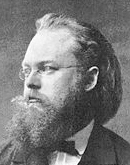

Camillo Sitte
*17. 4. 1843 – Wien, Austria
†16. 11. 1903 – Wien, Austria
Biography
Camillo Sitte was an Austrian urban planner, architect, and painter. He was the son of the Czech-Austrian architect Franz Sitte (1818-79), who studied at the Vienna Academy under Pietro Nobile. Camillo Sitte studied architecture at the Vienna University of Technology, followed by art history and archaeology. He traveled to Italy, Greece, and Egypt. In 1875, he became the director of the newly established State School of Arts and Crafts in Salzburg. In 1883, he founded and led a similar school in Vienna. He is the author of the book "The Construction of Cities According to Artistic Principles," which describes the principles of designing urban spaces and the management of dominant elements in these spaces. In this book, he also expressed his protest against the ambitious construction of Vienna's Ringstrasse. In 1894, he applied for a position as a professor of architecture at the Vienna Academy of Fine Arts, but despite his considerable fame, he was not appointed.
He influenced Czech architecture in November 1889 when he lectured in Olomouc on modern city building. In the following years, he developed urban plans for a number of Moravian and Czech cities (for example, for Děčín, Olomouc, Liberec, and Teplice). Numerous of his designs and works can be found in Ostrava. In 1893, he created the urban plan for the development of the city center of Přívoz. The most significant buildings were the Neo-Baroque town hall built in 1896-97 (the current seat of the Archive of the City of Ostrava) and the Neo-Gothic parish church of the Immaculate Conception of the Virgin Mary. Sitte also designed a new city center for Mariánské Hory and its landmark, the parish church of the Queen of Heaven.
Camillo Sitte was an Austrian urban planner, architect, and painter. He was the son of the Czech-Austrian architect Franz Sitte (1818-79), who studied at the Vienna Academy under Pietro Nobile. Camillo Sitte studied architecture at the Vienna University of Technology, followed by art history and archaeology. He traveled to Italy, Greece, and Egypt. In 1875, he became the director of the newly established State School of Arts and Crafts in Salzburg. In 1883, he founded and led a similar school in Vienna. He is the author of the book "The Construction of Cities According to Artistic Principles," which describes the principles of designing urban spaces and the management of dominant elements in these spaces. In this book, he also expressed his protest against the ambitious construction of Vienna's Ringstrasse. In 1894, he applied for a position as a professor of architecture at the Vienna Academy of Fine Arts, but despite his considerable fame, he was not appointed.
He influenced Czech architecture in November 1889 when he lectured in Olomouc on modern city building. In the following years, he developed urban plans for a number of Moravian and Czech cities (for example, for Děčín, Olomouc, Liberec, and Teplice). Numerous of his designs and works can be found in Ostrava. In 1893, he created the urban plan for the development of the city center of Přívoz. The most significant buildings were the Neo-Baroque town hall built in 1896-97 (the current seat of the Archive of the City of Ostrava) and the Neo-Gothic parish church of the Immaculate Conception of the Virgin Mary. Sitte also designed a new city center for Mariánské Hory and its landmark, the parish church of the Queen of Heaven.
The English translation is powered by AI tool. Switch to Czech to view the original text source.










